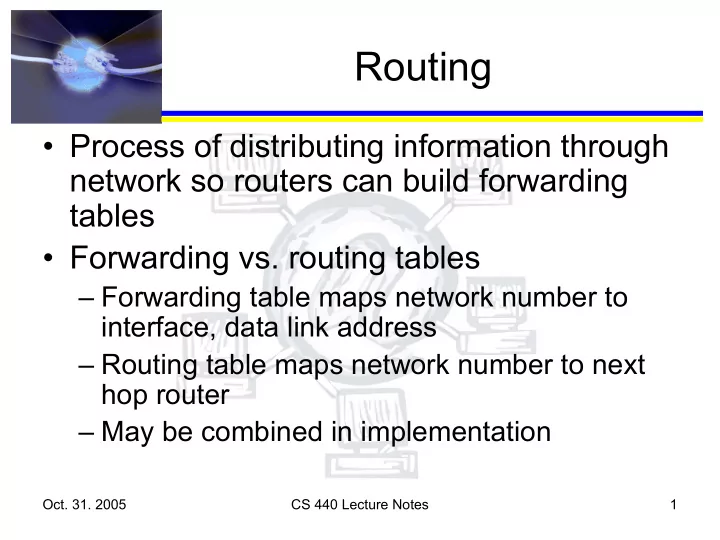

Routing • Process of distributing information through network so routers can build forwarding tables • Forwarding vs. routing tables – Forwarding table maps network number to interface, data link address – Routing table maps network number to next hop router – May be combined in implementation Oct. 31. 2005 CS 440 Lecture Notes 1
Routing (cont.) • To scale, organize routing into hierarchy – Intradomain routing – interior gateway protocols (IGPs) – Interdomain routing • Domain is a relatively small collection of networks, typically under the same administrative control Oct. 31. 2005 CS 440 Lecture Notes 2
Networks as Graphs • Vertices are routers, edges are links. – Each edge has a cost that indicates how expensive that link is • Routing is graph problem – find lowest- cost path between two vertices • Want to maintain information dynamically, to tolerate link or node failures, handle additions, and allow costs to change Oct. 31. 2005 CS 440 Lecture Notes 3
Network Graphs (cont.) • Graph problem is distributed among routers, which creates potential problems – Different routers can disagree about the current state of the network graph – Can create loops between routers until difference is resolved Oct. 31. 2005 CS 440 Lecture Notes 4
Distance Vector Routing • Also known as Bellman-Ford algorithm • Each node builds table of distances to other nodes – Initially, assume node knows cost to each directly connected neighbor; simple measure is to assign value of 1 to each link – Broken links or links with unknown cost assigned infinite cost Oct. 31. 2005 CS 440 Lecture Notes 5
Distance Vector Routing (cont.) • Each node then distributes this table to all immediate neighbors • When router receives table from neighbor, it merges the table with its own – If entry in neighbor’s table plus cost of link from neighbor is smaller than node’s current entry, replace – If value is larger, ignore Oct. 31. 2005 CS 440 Lecture Notes 6
Distance Vector Routing (cont.) • After exchanging updates repeatedly, every node’s table will converge to a static state • Two update mechanism – Periodic: node sends information at regular intervals, even if nothing has changed (frequency seconds to minutes) – Triggered: whenever table changes, send out update Oct. 31. 2005 CS 440 Lecture Notes 7
Link or Node Failure • Nodes monitor links – Actively, by sending control message – Passively, by watching for routing updates • If link is down, node changes cost to ∞ and sends out update • If a neighbor’s path to some destination is through the node, neighbor needs to update its own table Oct. 31. 2005 CS 440 Lecture Notes 8
Link or Node Failure (cont.) • This update might trigger additional cascading updates; network will eventually reconverge • Can create count-to-infinity problem – Cycle in graph can lead to nodes on cycle constantly updating counts, never realizing that a node is down Oct. 31. 2005 CS 440 Lecture Notes 9
Count-to-Infinity Solutions • Simplistic: pick a relatively small number and consider anything > that as infinity – Breaks down if network size exceeds that limit • Split horizon solution – Keep track of where node learned about route – Don’t send updates to a route to neighbor from which node learned about route – Poison reverse – actually send update with infinite cost to guarantee neighbor won’t use Oct. 31. 2005 CS 440 Lecture Notes 10
Count-to-Infinity (cont.) • Only works for cycle between two nodes • For larger cycles, can introduce delay; node doesn’t send out update to table immediately – Can slow convergence – Alternative is link-state routing Oct. 31. 2005 CS 440 Lecture Notes 11
Routing Information Protocol (RIP) • Standard distance vector-based protocol widely used in IP networks – Entries are networks rather than nodes – Can support other address families besides IP • RIP sends updates every 30 sec. • Every link’s cost is 1 (so distance is just hop count) • 16 is considered infinite Oct. 31. 2005 CS 440 Lecture Notes 12
Recommend
More recommend